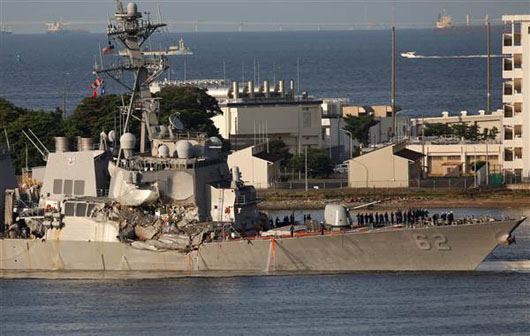by WorldTribune Staff, June 23, 2017
The Philippine-flagged cargo ship that hit a high tech U.S. destroyer was under control of a computerized navigation system when the incident occurred in the sea off the coast of Japan, U.S. Navy officials said.
Investigators say they have found no evidence the impact with the USS Fitzgerald, in which seven U.S. sailors were killed, was deliberate, security correspondent Bill Gertz reported. However many questions remain unanswered and multiple investigations by the U.S. and Japan are being conducted.

The collision with the U.S. Arleigh Burke-class guided missile destroyer occurred at around 1:30 a.m. local time but was not reported by the crew of the ACX Crystal cargo vessel until around 2:25 a.m. Investigators believe the time lag was the result of the crew not realizing they had hit another ship.
Private naval analyst Steffan Watkins said the fact that the ACX Crystal, while on autopilot, hit something and did not radio the Japanese coast guard for almost 30 minutes indicates no one was on the bridge at the time of the collision.
Related: Collision? Ramming of the USS Fitzgerald has raised serious questions, few answers, June 19, 2017
After colliding with the USS Fitzgerald, the ACX Cystal sailed on for another 15 minutes, increasing speed before eventually reducing speed and turning around. “This shows the autopilot was engaged because nobody would power out of an accident with another ship and keep sailing back on course. It’s unthinkable,” Watkins told the Washington Free Beacon.
An accident during computerized navigation also “raises the possibility the container ship’s computer system could have been hacked and the ship deliberately steered into the USS Fitzgerald,” the Beacon report said.
American Thinker reported that it received an email from a U.S. Navy mother whose son was aboard the Fitzgerald that raises serious questions.
The email (named redacted by American Thinker) said:
“My son is assigned to the USS Fitzgerald. I am unable to share his rate with you.
The information is short and not so sweet. The implications are disturbing.
The ship is registered in the Philippines. We do not know who the owner is. The container ship neither had its running lights or transponder on. That is an action taken willfully. Furthermore, for the container ship to strike with such accuracy is troublesome. Given what some have done with cars in Europe, what a feather in the cap it would be to sink a U.S. Navy warship. Think on that.
My son missed being washed out to sea by the blink of an eye. He was on his way to one of the berthing areas that was rammed.
Yes, language is important. ‘Rammed’ is the perfect word.”
Commercial ship autopilot systems normally require someone to input manually the course for the ship travel. The system also can be synchronized with an electronic chart system to allow the program to follow courses of a voyage plan.
The Beacon report said that the “more likely explanation is that the collision was the result of an autopilot malfunction, or the autopilot’s warning signals, used to notify the ship’s operators, were missed.”
Letters to the Editor __ Subscribe to Geostrategy-Direct __ Support Free Press Foundation
